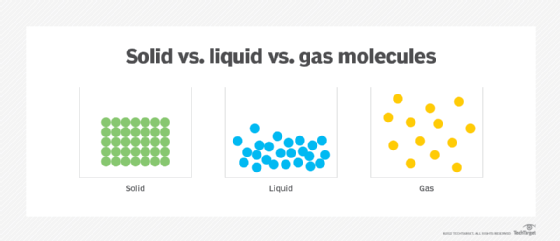gas
What is a gas?
A gas is a substance that is in a gaseous, or vaporous, state of matter. The term gas is also used in reference to the state itself when applied to matter that has the properties of a gaseous substance. Gas is one of four natural states of matter, along with liquid, solid and plasma.
A gas has no fixed shape or volume. The atoms or molecules that make up the gas fill the container that holds them. The gas expands until it is uniformly distributed throughout the container, even in the presence of gravity. If not confined to a container, a gas disperses into space.
The atoms or molecules of matter in the gaseous state are in a constant state of motion. They move freely around each other and continuously collide with each other and the wall of the container that holds them. Usually, the atoms or molecules are packed more loosely than they are if the substance is in the solid or liquid state.
How do gases differ from solids and liquids?
Figure 1 shows the molecules of a substance in three states of matter: solid, liquid and gas. The illustration implies that the molecules are composed of a diatomic element in which each molecule consists of two atoms of the same element, such as hydrogen (H2), nitrogen (N2), oxygen (O2) or chlorine (Cl2). However, transitioning between states is common to most matter. At a certain temperature, a substance moves from one state to another, becoming solid at lower temperatures and becoming gaseous at higher temperatures.

Because the particles in a gas are so widely distributed across the volume, the gas can be compressed with little difficulty. A liquid has a fixed volume and cannot be easily compressed because the particles are packed more tightly together. Like a gas, however, a liquid has no fixed shape. The particles can slide past each other and take the form of the container, although their movement is much more curtailed than with a gas. The particles in a solid are packed even more closely together, so like a liquid, it too cannot be easily compressed. Particles also are harder to move in a solid compared to a liquid or gas. A solid has both a fixed shape and a volume.
What are characteristics of gases?
Examples of gases are oxygen at room temperature -- approximately 20 degrees Celsius or 68 degrees Fahrenheit -- hydrogen at room temperature and water when it exceeds 100 degrees C or 212 degrees F at standard atmospheric pressure (sea level). These and other gases are characterized by four physical properties:
- Volume. The amount of space the gas occupies.
- Density. The amount of mass in a specific volume, i.e., how tightly the particles are packed together.
- Temperature. The absolute temperature of the gas.
- Pressure. The amount of force the gas exerts on the container holding it.
All four properties play a vital role in how a gas behaves under different circumstances:
- When a gas is heated, the atoms or molecules gain kinetic energy and move more rapidly.
- When a gas is cooled, the atoms or molecules lose kinetic energy and move more slowly.
- If a gas is in a sealed container and heated, the pressure increases.
- If a gas is in a sealed container and cooled, the pressure drops.
- If a gas is in a sealed container and the container's volume is reduced, the compression heats the gas.
- If a gas is in a sealed container and the container's volume is increased, the decompression cools the gas.
When temperatures become sufficiently high, gases such as hydrogen can rapidly combine with gases such as oxygen or chlorine, causing them to combust. Some chemical reactions between gases and other substances occur more slowly. For example, the gradual oxidation of iron results in iron oxide (rust). In this case, oxygen, a gas, combines with iron, a solid, to create iron oxide, another solid.
Most gases transition to the liquid or solid state if their temperatures drop low enough. For example, if nitrogen is chilled to a temperature below -196 degrees C or -320 degrees F, it liquefies. Liquid nitrogen is used in medicine to destroy minor skin lesions, such as warts, keloids or keratoses. Another gas, carbon dioxide, skips the liquid phase and becomes a solid known as dry ice when cooled to below -78 degrees C or -109 degrees F.
Understanding the characteristics of gases, liquids and solids is useful for IT leaders who need to ensure efficient cooling of the data center and who increasingly are concerned with lowering their organization's digital carbon footprint.
